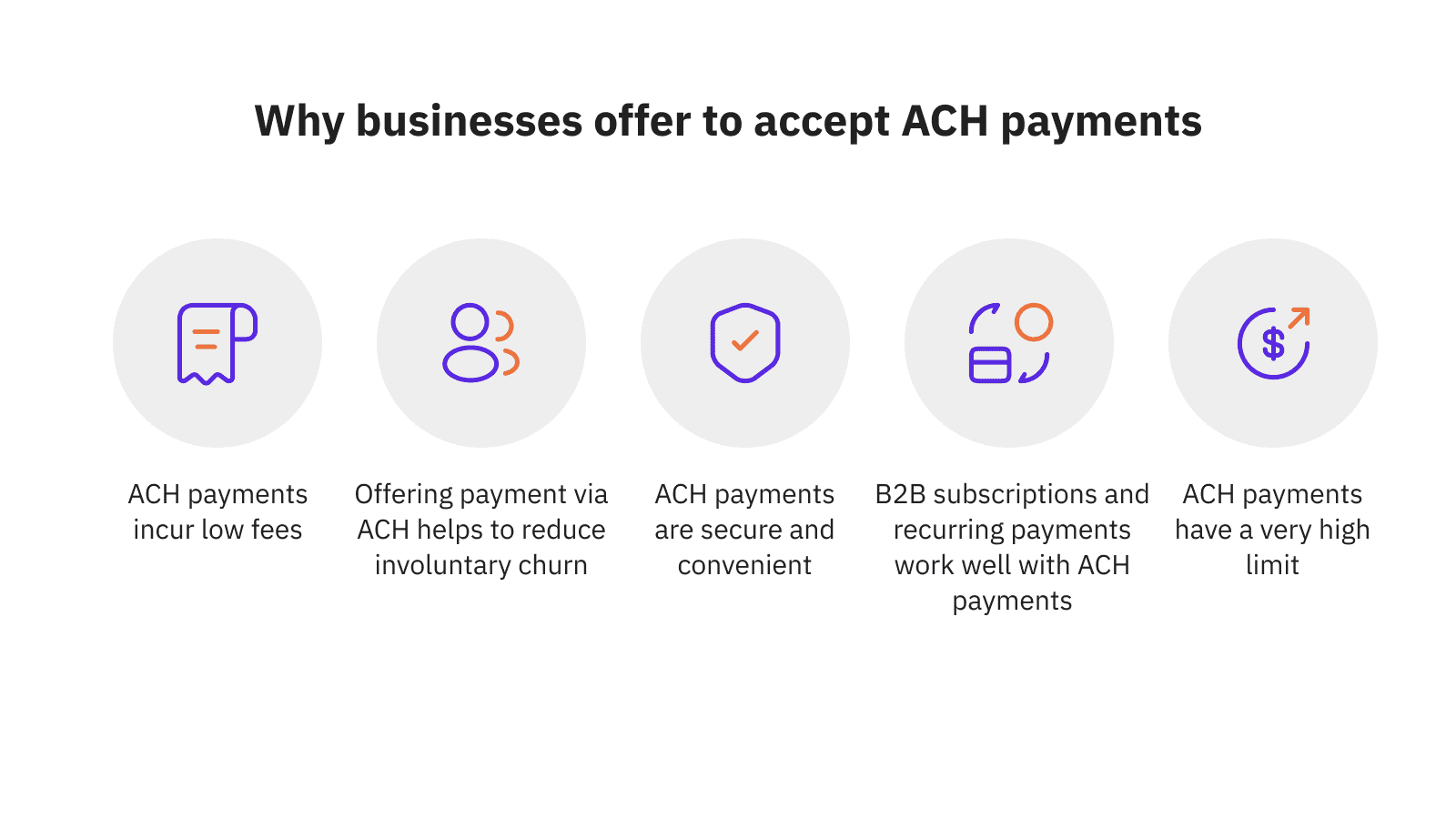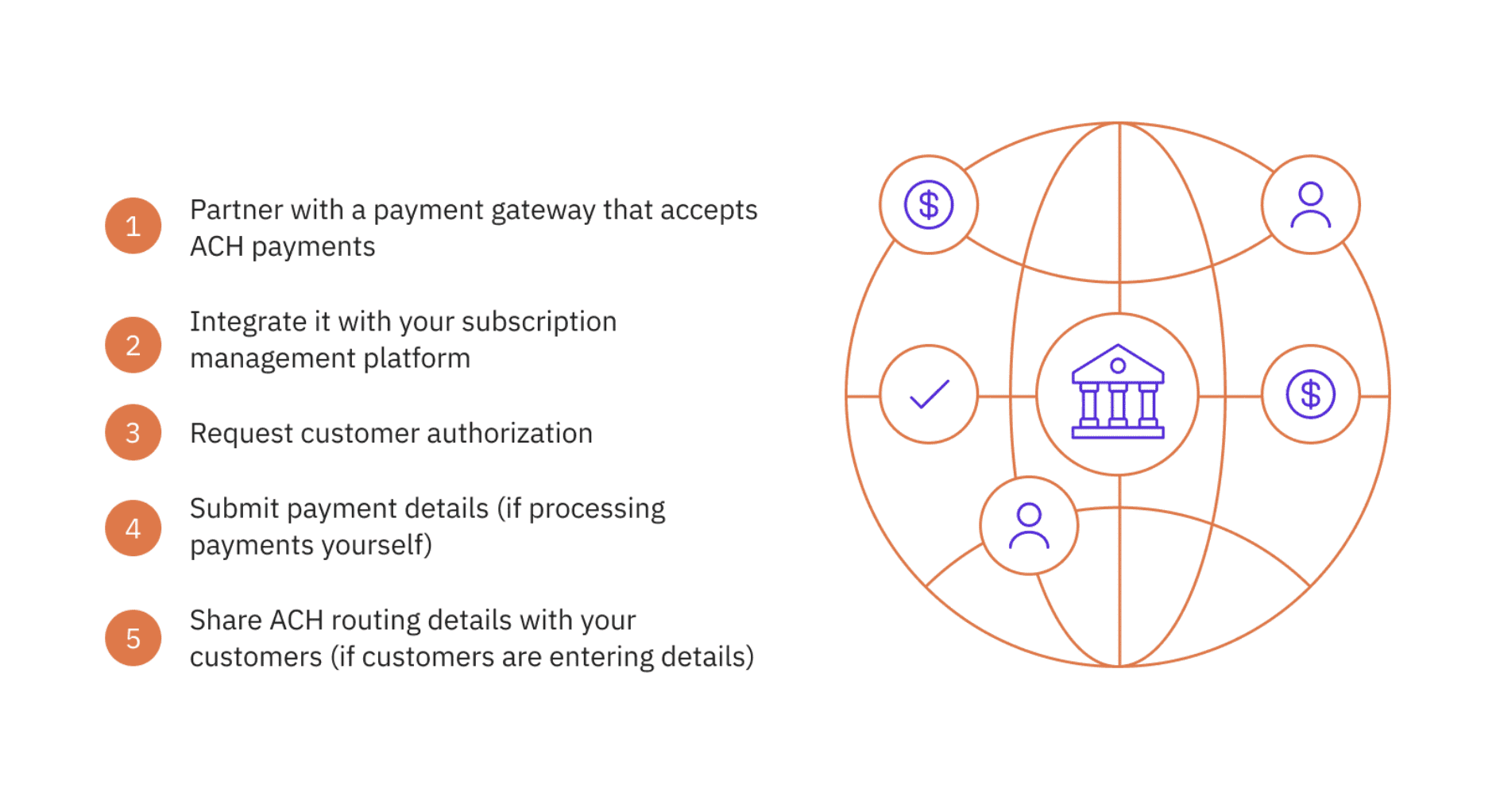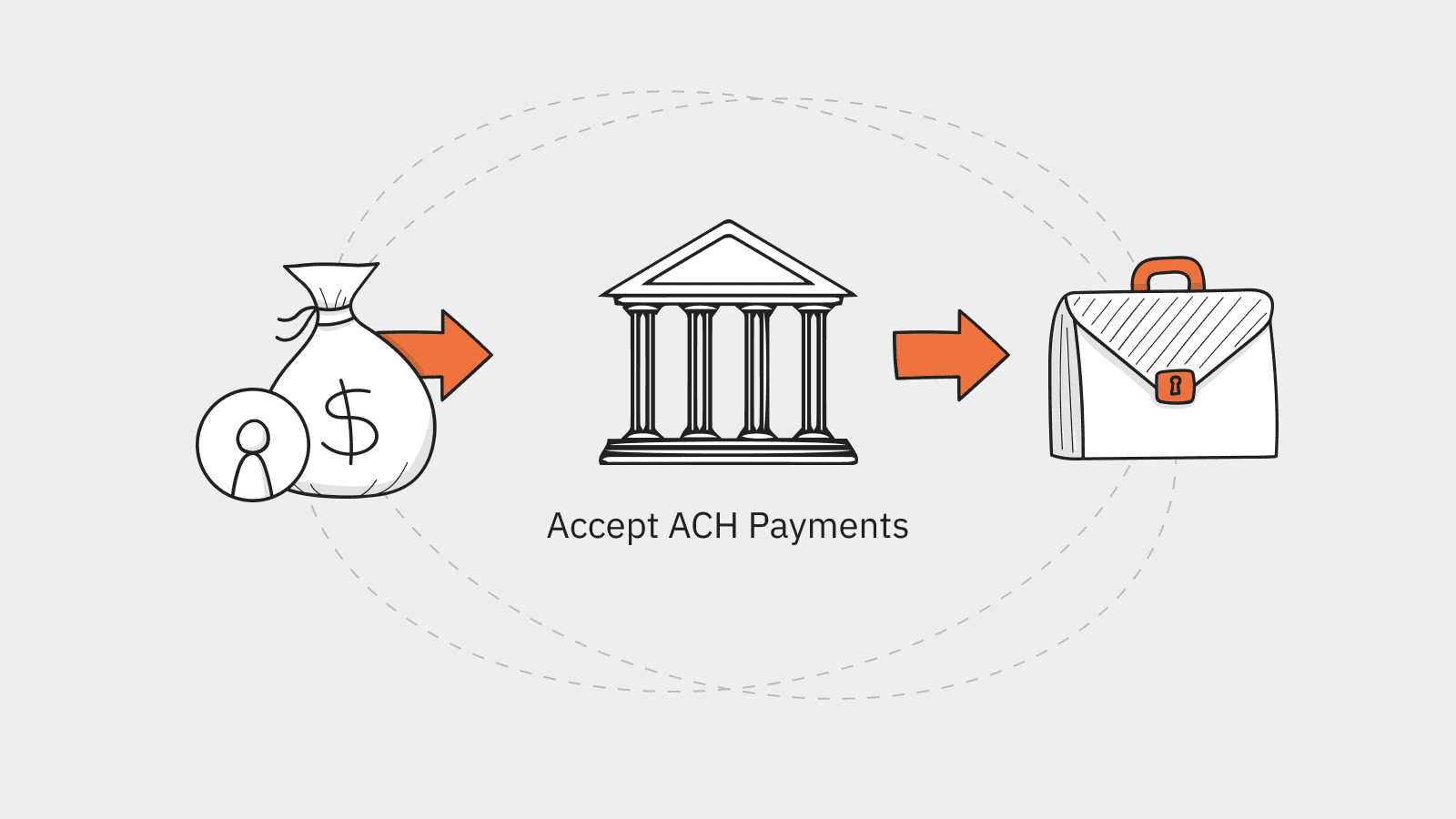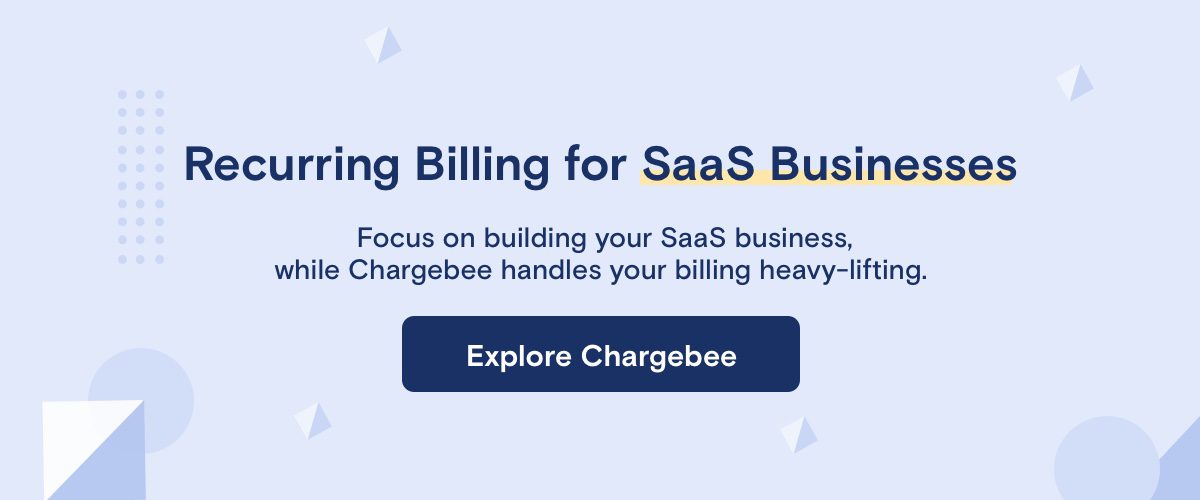Forrester predicts that bank-based payment methods like ACH will have their first “big” debut in 2023, with at least one major global retailer beginning to accept ACH-based payments on their site. (source)
This is great news for retailers and subscription-based businesses, who can take advantage of the low transaction fees involved with ACH (Automated Clearing House) payments. This will help them combat the interchange fees charged by card networks, an issue so concerning to retailers that it was brought in front of Congress in 2022.
This article will walk you through the basics of ACH payments. We’ll also discuss the benefits of accepting ACH payments and guide you through the process of setting up your business to accept ACH payments.
What Are ACH Payments and How Do They Work?
ACH payments are an electronic form of bank-to-bank money transfer. In the context of ACH payments for business, this transfer is from your customer’s account to yours.
ACH stands for Automated Clearing House, which is a network of financial institutions (banks and credit unions) that facilitates interbank payments in the US.
The ACH network is essentially a centralized clearing system. Rather than processing bank-to-bank transfers on a one-by-one basis, all payments are processed through the clearing house and reconciled between banks in batches at the end of each day.
This minimizes the actual number of fund transfers that happen between banks, which allows banks to reduce the fees they charge their customers (i.e. you).
What is the Cost of Accepting ACH Payments ?
While the cost of ACH payments is generally low (especially when compared to alternatives like wire transfers), the actual amount you pay can vary significantly depending on two things: the number of payments you accept each month and the method used to access ACH.
If you’re accessing ACH directly through your bank, they may not charge a fee at all for standard transfers.
If, like most organizations, you’re processing ACH payments using a third-party payment processor (TPPP), then you’ll incur a variety of small fees.
TPPPs charge the receiver either a flat or percentage rate for ACH payments. Flat fee charges generally range between $0.20 and $1.50 per transaction, while percentage fees are mostly around the 1% mark (0.5% to 1.5% on average).
Depending on the payment processor you use, there may be a variety of other fees involved, such as:
- Batch ACH payment processing fee (generally under $1)
- Monthly ACH fee ($5-30 per month)
- ACH return fee ($2-5 per return)
- ACH chargeback fee ($5-25 per instance)
Some payment processors may also charge a setup fee, and offer expedited processing at an additional charge. This might sound like a lot, but the median cost to initiate and receive ACH transactions is between $0.26 and $0.50.
Comparing this to other popular B2B payment methods helps you to understand the value of using ACH to process customer payments.
Wire transfers generally cost around $14 for domestic transfers and $50 for international payments. Paper check processing averages $2.01 to $5.00 per transaction.
For credit card payments (one of the more popular electronic payment options for B2B subscription billing), fees are as high as 3 to 4%.
Stripe, for example, charges 2.9% per transaction plus a 30c card processing fee for each successful payment. For a $5,000 charge, that’s almost $150 in fees.
ACH payments are therefore several times cheaper than other options.
ACH Payments vs. Wire Transfers vs. Credit Card Payments
ACH payments differ from other common payment methods like wire transfers and credit card processing.
Here are the main differences:
| ACH Payments | Wire Transfers | Credit Card Payments | |
| Speed | Generally takes a few days, but same-day processing is also available | Instant | Instant |
| Cost | The typical transaction cost is between 26c and 50c. Costs vary based on the payment gateway you use, but you’re generally looking at a fee of around 0.75% of the transaction amount, paid by the receiver. | Both the sender and receiver pay a fee. Average fees are around $14 for domestic payments and up to $75 for international transfers. | Fees are generally between 2.5% and 3.2% |
| Cancelation terms | Can be disputed under certain conditions | Cannot be canceled once initiated | Can be disputed under certain conditions |
| Human involvement | Automated (no humans involved) | Generally involves bank staff | Automated (no humans involved) |
| Processing | Processed in batches | Processed in real-time | Processed in real-time |
Why Businesses Offer to Accept ACH Payments ?
Businesses of all kinds and sizes, from e-commerce startups to enterprise SaaS companies, use ACH transactions to receive funds from their customers.
Here’s why.

1. ACH Payments Incur Low Fees
Because ACH transfers are processed by the clearing house in batches, there are very few fees involved.
The typical fee for an ACH transaction is around 0.75%, though the actual TDR (Transaction Discount Rate) varies based on the payment gateway you use.
Compare this to the fees charged by credit card companies, which typically run in the range of 2.5% of the transaction value.
For a customer that’s paying $10,000 a month, this cuts your fee down from $250 to $75. And, that’s a direct saving of around 70%.
This means ACH debit payments are a great way to maximize the actual revenue you receive from each payment.
2. Offering Payment Via ACH Helps to Reduce Involuntary Churn
Failed credit card payments are still one of the leading reasons for involuntary churn, where a customer’s subscription can’t be renewed due to an expired or blocked card.
Failed payments using ACH are much rarer and generally only occur as a result of insufficient funds in the customer’s account.
Unlike credit cards, bank accounts don’t expire and account numbers rarely change.
Furthermore, ACH payments include a two-level verification process (the customer needs to be verified by the clearing house). This acts as a pre-payment touchpoint that reduces the likelihood of a failed direct debit payment while also delivering an additional layer of protection.
3. B2B Subscriptions and Recurring Payments Work Well With ACH
ACH payments is perfect for recurring payments.
In ACH debits, your customers don’t have to keep going back to update their credit/debit card details. The processing of these transactions is recurring and automated..
Once the customer is set up and has authorized payments to you, you can use your recurring billing solution to automatically process payments each month, quarter, or year (depending on the customer contract).
4. ACH Offers More Control
In ACH debit transactions, your ACH processor will ensure that the pre-defined funds automatically land in your account on the pre-defined date (in the absence of any disputes). You can set recurring as well as one-off payments and manage all of them in one place.
How to Set up your Business to Accept ACH Payments Instantly?

1. Partner With a Payment Gateway That Accepts ACH Payments
While some larger organizations can get approved by Nacha to process ACH payments internally, this is mostly outside of scope for smaller businesses. To start accepting ACH payments, they’ll need a payment gateway.
The good news is that the majority of payment gateways that process credit and debit cards (you’re probably already using one) also accept ACH payments.
Popular examples of payment gateways that accept ACH payments include:
- Stripe
- BlueSnap
- GoCardless
- Braintree
- Mollie
- Checkout.com
2. Integrate It With Your Subscription Management Platform
If you’re a subscription based business collecting recurring payments from your customers, you’ll need to set up an integration between your payment gateway and your subscription management platform.
This will allow you to automate subscription billing using ACH payments, saving you time each month and creating a more seamless customer experience.
See how Chargebee can help you to handle direct debit payments and recurring billing
3. Request Customer Authorization
At this point, you’re set up to accept ACH payments but your customers aren’t. Start the switch to ACH by sending a formal customer authorization to charge via ACH.
Most companies will use a formal written agreement to process ACH payments.
However, there are several other routes you can take, all of which constitute authorization:
- Written confirmation via email
- A recorded voice note or phone call
- Submission of an online payment form
Whichever option you choose to use, be sure to store your authorizations safely should a dispute ever arise in the future.
From here, you have two choices: you can either collect customer bank details and submit the ACH payment yourself, or share your own bank details for the customer to process an ACH payment.
The first is more likely, especially if you’re using a payment gateway, as it allows to maintain control over the payments processing and eliminates the need to follow up with a customer to check that payment has been sent.
4. Submit Payment Details (If You’re Processing Payments Yourself)
If you’re processing ACH payments on your end (via your payment gateway), you’ll need to collect and verify your customers’ bank account details.
Request the relevant account information:
- Customer name
- Bank name
- Account type (e.g. checking account or savings account)
- Account number
- Routing number
Submit this information to your payment gateway, then, use a micro-deposit (a small one-off charge, usually 1c) to verify the account details before processing the larger transaction. This is not mandatory, but it’s a good safety precaution to prevent charging the wrong account accidentally.
This will help prevent ACH returns and minimize the fees you end up paying.
5. Share ACH Routing Details With Your Customers (If They’re Setting Up Payments)
If your customers are going to be sending ACH payments from their end, you’ll need to provide your own bank information (as per the above).
Be sure to request confirmation of payment from your customer so you can then reconcile payments and provide receipts once the funds are through.


